Microsphere Peptide-Based Immunoassay for the Detection of Recombinant Bovine Somatotropin in Injection Preparations
Abstract
:1. Introduction
2. Materials and Methods
2.1. Materials
2.2. Epitope Mapping
2.3. Peptide Synthesis
2.4. Peptide Purification
2.5. Microsphere Preparation for Microsphere Peptide-Based Immunoassays (MIPA)
2.6. Inhibition MIPA Procedure
2.7. Extraction of rbSTs of Injection Preparations
2.8. X-ray Photoelectron Spectroscopy (XPS)
3. Results and Discussion
3.1. Identification of Epitopes Recognized by MAb 4H12 in rbST
3.2. Performance of the Microsphere Peptide-Based Immunoassay (MIPA)
3.3. Application of MIPA to Somatotropin Injection Samples
4. Conclusions
Supplementary Materials
Author Contributions
Funding
Institutional Review Board Statement
Informed Consent Statement
Data Availability Statement
Acknowledgments
Conflicts of Interest
References
- Li, Y.; Lai, D.; Lei, Q.; Xu, Z.; Wang, F.; Hou, H.; Chen, L.; Wu, J.; Ren, Y.; Ma, M.; et al. Systematic evaluation of IgG responses to SARS-CoV-2 spike protein-derived peptides for monitoring COVID-19 patients. Cell. Mol. Immunol. 2021, 18, 621–631. [Google Scholar] [CrossRef] [PubMed]
- Liu, B.-S.; Wu, W.-G.; Lin, M.-H.; Li, C.-H.; Jiang, B.-R.; Wu, S.-C.; Leng, C.-H.; Sung, W.-C. Identification of immunoreactive peptides of toxins to simultaneously assess the neutralization potency of antivenoms against neurotoxicity and cytotoxicity of naja atra venom. Toxins 2018, 10, 10. [Google Scholar] [CrossRef] [PubMed] [Green Version]
- de Melo, P.D.V.; Lima, S.D.A.; Araújo, P.; Santos, R.M.; Gonzalez, E.; Belo, A.A.; de Ávila, R.A.M.; Costal-Oliveira, F.; Soccol, V.T.; Guerra-Duarte, C.; et al. Immunoprotection against lethal effects of Crotalus durissus snake venom elicited by synthetic epitopes trapped in liposomes. Int. J. Biol. Macromol. 2020, 161, 299–307. [Google Scholar] [CrossRef] [PubMed]
- De-Simone, S.G.; Gomes, L.R.; Napoleão-Pêgo, P.; Lechuga, G.C.; Pina, J.S.D.; Silva, F.R.D. Epitope mapping of the diphtheria toxin and development of an elisa-specific diagnostic assay. Vaccines 2021, 9, 313. [Google Scholar] [CrossRef]
- Van der Wal, F.J.; Jelsma, T.; Fijten, H.; Achterberg, R.P.; Loeffen, W.L.A.J. Towards a peptide-based suspension array for the detection of pestivirus antibodies in swine. Virol. Methods 2016, 235, 15–20. [Google Scholar] [CrossRef] [Green Version]
- Klisara, N.; Peters, J.; Haasnoot, W.; Nielen, M.W.; Palaniappan, A.; Liedberg, B. Functional fluorescence assay of botulinum neurotoxin A in complex matrices using magnetic beads. Sens. Actuators B Chem. 2018, 281, 912–919. [Google Scholar] [CrossRef]
- Qu, P.; Zhang, C.; Li, M.; Ma, W.; Xiong, P.; Liu, Q.; Zou, G.; Lavillette, D.; Yin, F.; Jin, X.; et al. A new class of broadly neutralizing antibodies that target the glycan loop of Zika virus envelope protein. Cell Discov. 2020, 6, 1–14. [Google Scholar] [CrossRef] [Green Version]
- Suprun, M.; Getts, R.; Raghunathan, R.; Grishina, G.; Witmer, M.; Gimenez, G.; Sampson, H.A.; Suárez-Fariñas, M. Novel Bead-Based Epitope Assay is a sensitive and reliable tool for profiling epitope-specific antibody repertoire in food allergy. Sci. Rep. 2019, 9, 1–14. [Google Scholar] [CrossRef] [Green Version]
- Sackesen, C.; Erman, B.; Gimenez, G.; Grishina, G.; Yilmaz, O.; Yavuz, S.T.; Sahiner, U.M.; Buyuktiryaki, B.; Yilmaz, E.A.; Cavkaytar, O.; et al. IgE and IgG4 binding to lentil epitopes in children with red and green lentil allergy. Pediatr. Allergy Immunol. 2019, 31, 158–166. [Google Scholar] [CrossRef]
- Baker, M.G.; Sampson, H.A. Phenotypes and endotypes of food allergy: A path to better understanding the pathogenesis and prognosis of food allergy. Ann. Allergy Asthma Immunol. 2018, 120, 245–253. [Google Scholar] [CrossRef] [Green Version]
- Butler, L.J. The profitability of rBST on US dairy farms. Agbioforum 1999, 2, 111–117. [Google Scholar]
- Council Decision 1999/879/EC. Off. J. Eur. Comm. 1999, 42, 71–72.
- Smits, N.G.E.; Blokland, M.H.; Wubs, K.L.; Bovee, T.F.; Albada, B.; van Ginkel, L.A.; Nielen, M.W.F.J. Detection of methionine-and alanine-recombinant bovine somatotropins and their induced antibodies in serum and milk of cows suggests blood-milk barrier specificity for these compounds. Dairy Sci. 2021, 104, 5069–5078. [Google Scholar] [CrossRef] [PubMed]
- Ludwig, S.K.J.; Smits, N.G.E.; Bremer, M.G.E.G.; Nielen, M.W.F. Monitoring milk for antibodies against recombinant bovine somatotropin using a microsphere immunoassay-based biomarker approach. Food Control 2012, 26, 68–72. [Google Scholar] [CrossRef]
- Smits, N.G.E.; Bremer, M.G.E.G.; Ludwig, S.K.J.; Nielen, M.W.F. Development of a flow cytometric immunoassay for recombinant bovine somatotropin-induced antibodies in serum of dairy cows. Drug Test. Anal. 2012, 4, 362–367. [Google Scholar] [CrossRef]
- Rochereau-Roulet, S.; Gaudin, I.; Chéreau, S.; Prévost, S.; André-Fontaine, G.; Pinel, G.; Le Bizec, B. Development and validation of an enzyme-linked immunosorbent assay for the detection of circulating antibodies raised against growth hormone as a consequence of rbST treatment in cows. Anal. Chim. Acta 2011, 700, 189–193. [Google Scholar] [CrossRef]
- Castigliego, L.; Tinacci, L.; Armani, A.; Boselli, C.; Grifoni, G.; Mazzi, M.; Guidi, A. Serum responsiveness to recombinant bovine somatotropin in buffalo: A three-month lactation study using an acid-stripping ELISA for screening. Drug Test. Anal. 2017, 9, 646–656. [Google Scholar] [CrossRef]
- Ludwig, S.K.J.; Tokarski, C.; Lang, S.N.; Van Ginkel, L.A.; Zhu, H.; Ozcan, A.; Nielen, M.W.F. Calling Biomarkers in Milk Using a Protein Microarray on Your Smartphone. PLoS ONE 2015, 10, e0134360. [Google Scholar] [CrossRef]
- Smits, N.G.E.; Ludwig, S.K.J.; Van der Veer, G.; Bremer, M.G.E.G.; Nielen, M.W.F. Multiplex flow cytometric immunoassay for serum biomarker profiling of recombinant bovine somatotropin. Analyst 2013, 138, 111–117. [Google Scholar] [CrossRef]
- Heutmekers, T.H.; Bremer, M.G.; Haasnoot, W.; Nielen, M.W. A rapid surface plasmon resonance (SPR) biosensor immunoassay for screening of somatotropins in injection preparations. Anal. Chim. Acta 2007, 586, 239–245. [Google Scholar] [CrossRef]
- McGrath, M.F.; Bogosian, G.; Fabellar, A.C.; Staub, R.L.; Vicini, J.L.; Widger, L.A. Measurement of Bovine Somatotropin (bST) and Insulin-like Growth Factor-1 (IGF-1) in bovine milk using an Electro chemiluminescent Assay. J. Agric. Food Chem. 2008, 56, 7044–7048. [Google Scholar] [CrossRef] [PubMed]
- SadAbadi, H.; Badilescu, S.; Packirisamy, M.; Wüthrich, R. Integration of gold nanoparticles in PDMS microfluidics for lab-on-a-chip plasmonic biosensing of growth hormones. Biosens. Bioelectron. 2013, 44, 77–84. [Google Scholar] [CrossRef] [PubMed]
- Lim, S.A.; Ahmed, M.U. A carbon nanofiber-based label free immunosensor for high sensitive detection of recombinant bovine somatotropin. Biosens. Bioelectron. 2015, 70, 48–53. [Google Scholar] [CrossRef] [PubMed]
- Andersen, P.H.; Nielsen, M.; Lund, O. Prediction of residues in discontinuous B-cell epitopes using protein 3D structures. Protein Sci. 2006, 15, 2558–2567. [Google Scholar] [CrossRef] [PubMed]
- Geysen, H.M.; Meloen, R.H.; Barteling, S.J. Use of peptide synthesis to probe viral antigens for epitopes to a resolution of a single amino acid. Proc. Natl. Acad. Sci. USA 1984, 81, 3998–4002. [Google Scholar] [CrossRef] [PubMed] [Green Version]
- Taitt, C.R.; Shriver-Lake, L.C.; Anderson, G.P.; Ligler, F.S. Surface Modification and Biomolecule Immobilization on Polymer Spheres for Biosensing Applications. In Biomedical Nanotechnology; Hurst, S.J., Ed.; Humana Press: New York, NY, USA, 2011; Volume 726, pp. 77–94. [Google Scholar]
- Matsueda, S.; Komatsu, N.; Kusumoto, K.; Koga, S.; Yamada, A.; Kuromatsu, R.; Yamada, S.; Seki, R.; Yutani, S.; Shichijo, S.; et al. Humoral immune responses to CTL epitope peptides from tumor-associated antigens are widely detectable in humans: A new biomarker for overall survival of patients with malignant diseases. Dev. Comp. Immunol. 2013, 41, 68–76. [Google Scholar] [CrossRef]
- Embers, M.E.; Hasenkampf, N.R.; Barnes, M.B.; Didier, E.S.; Philipp, M.T.; Tardo, A.C. Five-antigen fluorescent bead-based assay for diagnosis of lyme disease. Clin. Vaccine Immunol. 2016, 23, 294–303. [Google Scholar] [CrossRef] [Green Version]
- Fonseca, A.M.; Quintó, L.; Jiménez, A.; González, R.; Bardají, A.; Maculuve, S.; Dobaño, C.; Rupérez, M.; Vala, A.; Aponte, J.J.; et al. Multiplexing detection of IgG against Plasmodium falciparum pregnancy-specific antigens. PLoS ONE 2017, 12, e0181150. [Google Scholar] [CrossRef] [Green Version]
- Yufenyuy, E.L.; Parekh, B.S. Development of a multiplex assay for concurrent diagnoses and detection of HIV-1, HIV-2, and recent HIV-1 infection in a single test. AIDS Res. Hum. Retroviruses 2018, 34, 1017–1027. [Google Scholar] [CrossRef]
- Timmerman, P.; Puijk, W.C.; Meloen, R.H. Functional reconstruction and synthetic mimicry of a conformational epitope using CLIPS™ technology. J. Mol. Recog. 2007, 20, 283–299. [Google Scholar] [CrossRef]
- Bremer, M.G.E.G.; Smits, N.G.E.; Haasnoot, W.; Nielen, M.W.F. Multiplex ready flow cytometric immunoassay for total insulin like growth factor 1 in serum of cattle. Analyst 2010, 135, 1147–1152. [Google Scholar] [CrossRef] [PubMed]
- Jelsma, T.; Van Der Wal, F.J.; Fijten, H.; Dailly, N.; Van Dijk, E.; Loeffen, W.L. Pre-screening of crude peptides in a serological bead-based suspension array. J. Virol. Methods 2017, 247, 114–118. [Google Scholar] [CrossRef] [PubMed]
- Ayoglu, B.; Nilsson, P.; Schwenk, J.M. Multiplexed Antigen Bead Arrays for the Assessment of Antibody Selectivity and Epitope Mapping. In Epitope Mapping Protocols; Humana Press: New York, NY, USA, 2018; Volume 1785, pp. 239–248. [Google Scholar]
- Varela, M.L.; Mbengue, B.; Basse, A.; Loucoubar, C.; Vigan-Womas, I.; Dièye, A.; Toure, A.; Perraut, R. Optimization of a magnetic bead-based assay (MAGPIX®-Luminex) for immune surveillance of exposure to malaria using multiple Plasmodium antigens and sera from different endemic settings. Malar. J. 2018, 17, 1–9. [Google Scholar] [CrossRef] [PubMed]
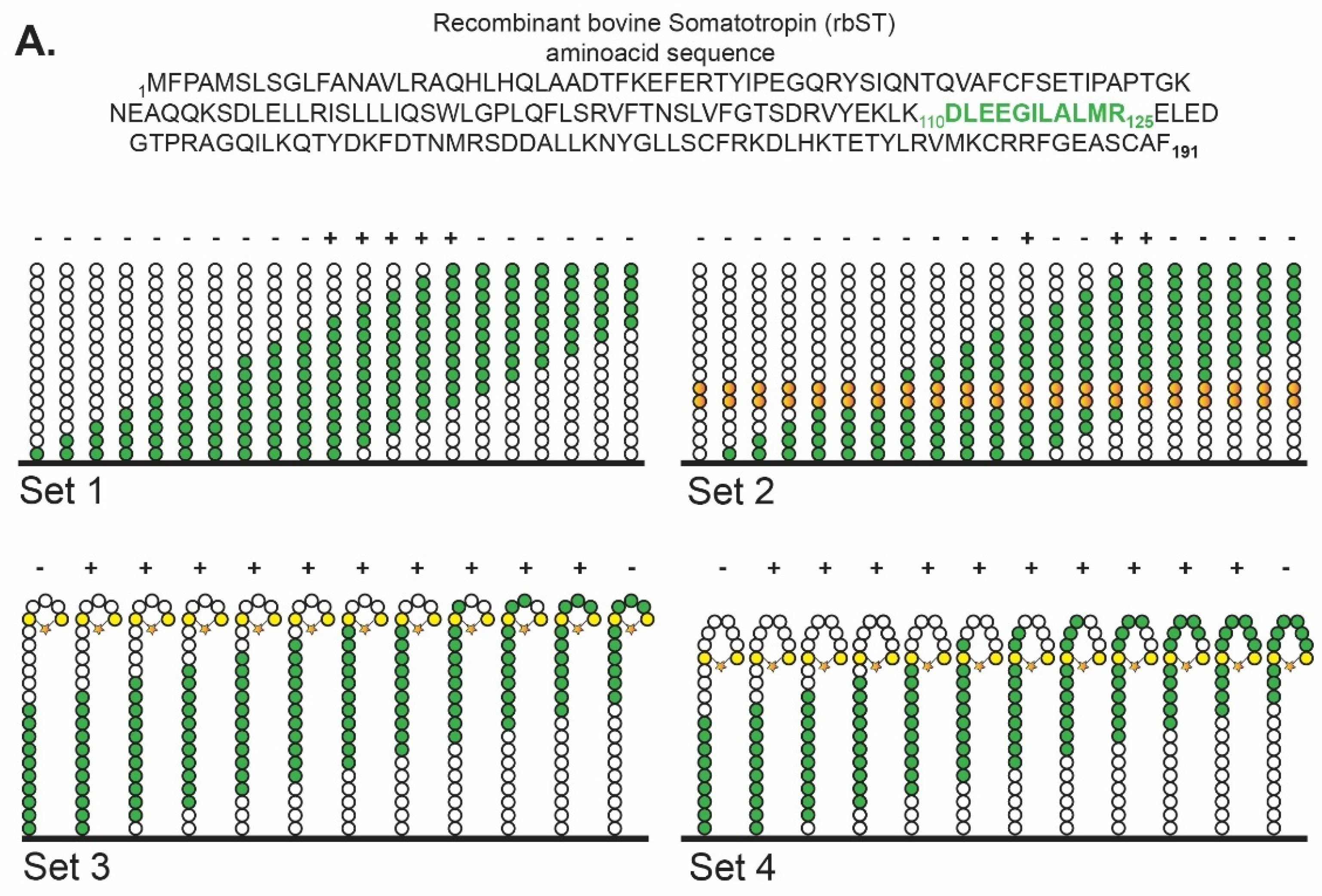
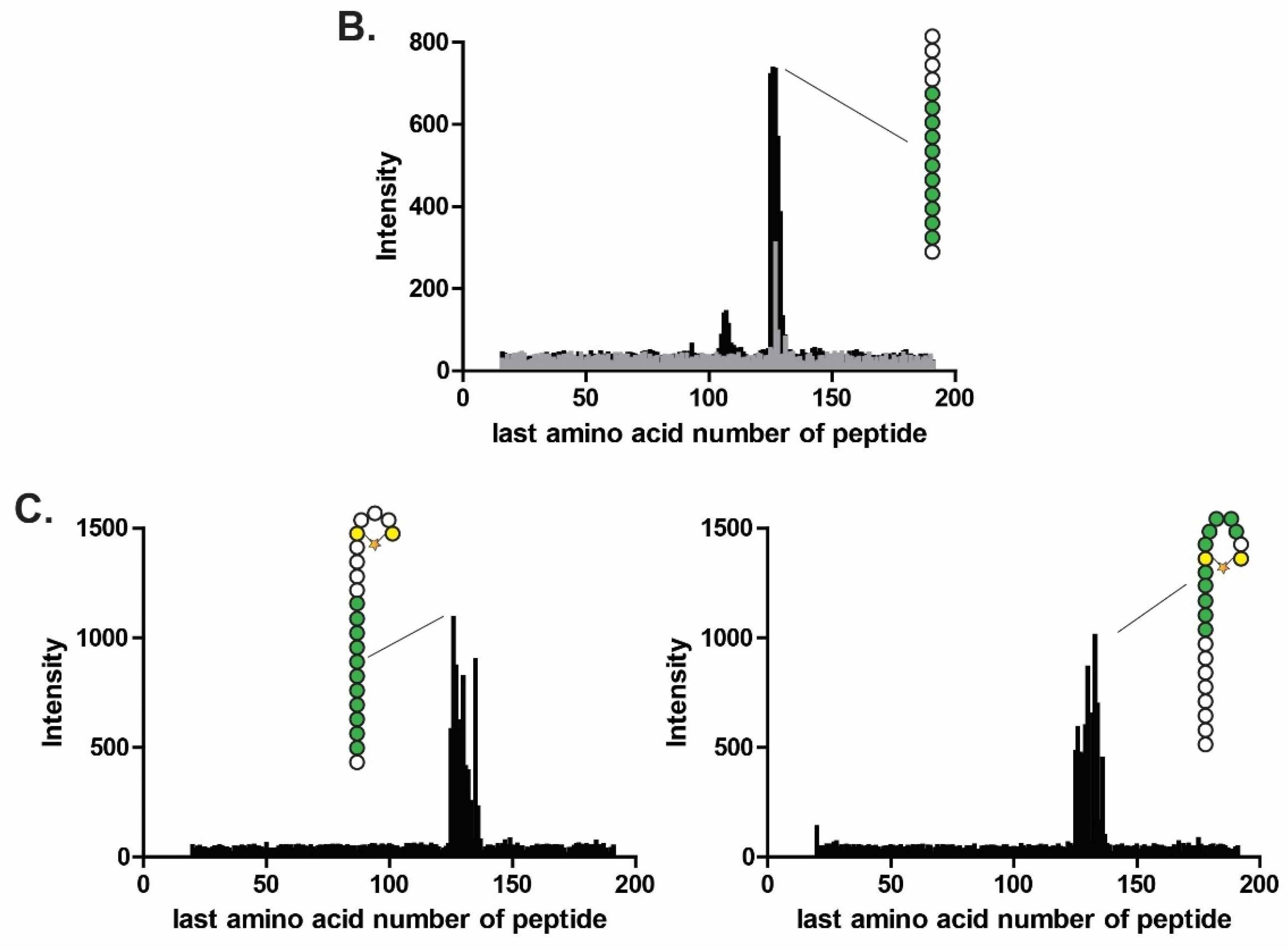

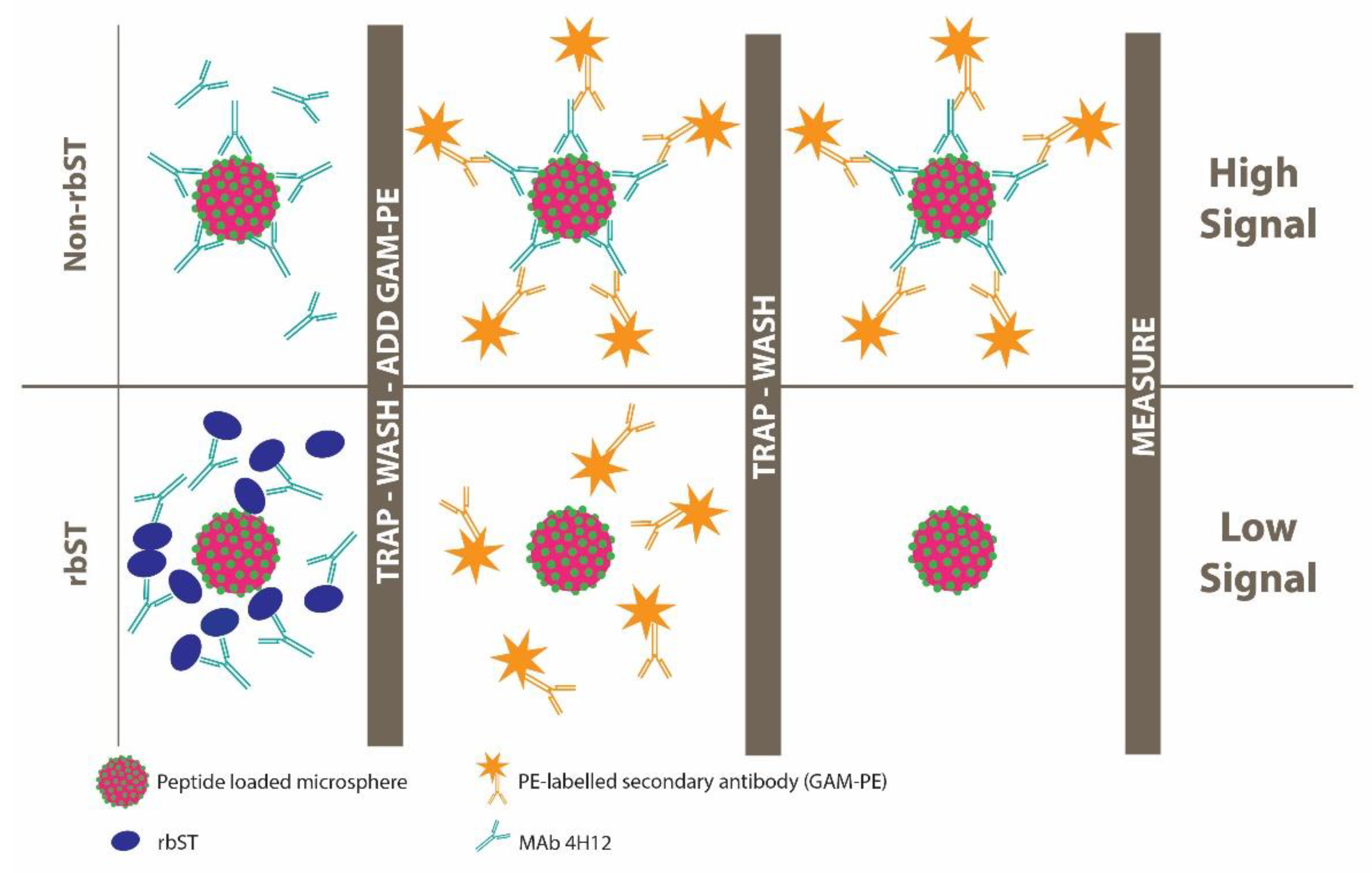
 ), pep-K (
), pep-K (  ), pep-peg (
), pep-peg (  ), pep-aca (
), pep-aca (  ) and the total rbST protein (
) and the total rbST protein (  ) (n = 3). Error bars display the standard deviations on B/B0 per tested rbST concentration for each individual microsphere set. The half maximal inhibitory concentration (IC50) for each individual microsphere set is shown in the top right corner of the graph. Pep-scr did not show any binding of the MAb; consequently, its inhibition could not be included in this figure.
) (n = 3). Error bars display the standard deviations on B/B0 per tested rbST concentration for each individual microsphere set. The half maximal inhibitory concentration (IC50) for each individual microsphere set is shown in the top right corner of the graph. Pep-scr did not show any binding of the MAb; consequently, its inhibition could not be included in this figure.
 ), pep-K (
), pep-K (  ), pep-peg (
), pep-peg (  ), pep-aca (
), pep-aca (  ) and the total rbST protein (
) and the total rbST protein (  ) (n = 3). Error bars display the standard deviations on B/B0 per tested rbST concentration for each individual microsphere set. The half maximal inhibitory concentration (IC50) for each individual microsphere set is shown in the top right corner of the graph. Pep-scr did not show any binding of the MAb; consequently, its inhibition could not be included in this figure.
) (n = 3). Error bars display the standard deviations on B/B0 per tested rbST concentration for each individual microsphere set. The half maximal inhibitory concentration (IC50) for each individual microsphere set is shown in the top right corner of the graph. Pep-scr did not show any binding of the MAb; consequently, its inhibition could not be included in this figure.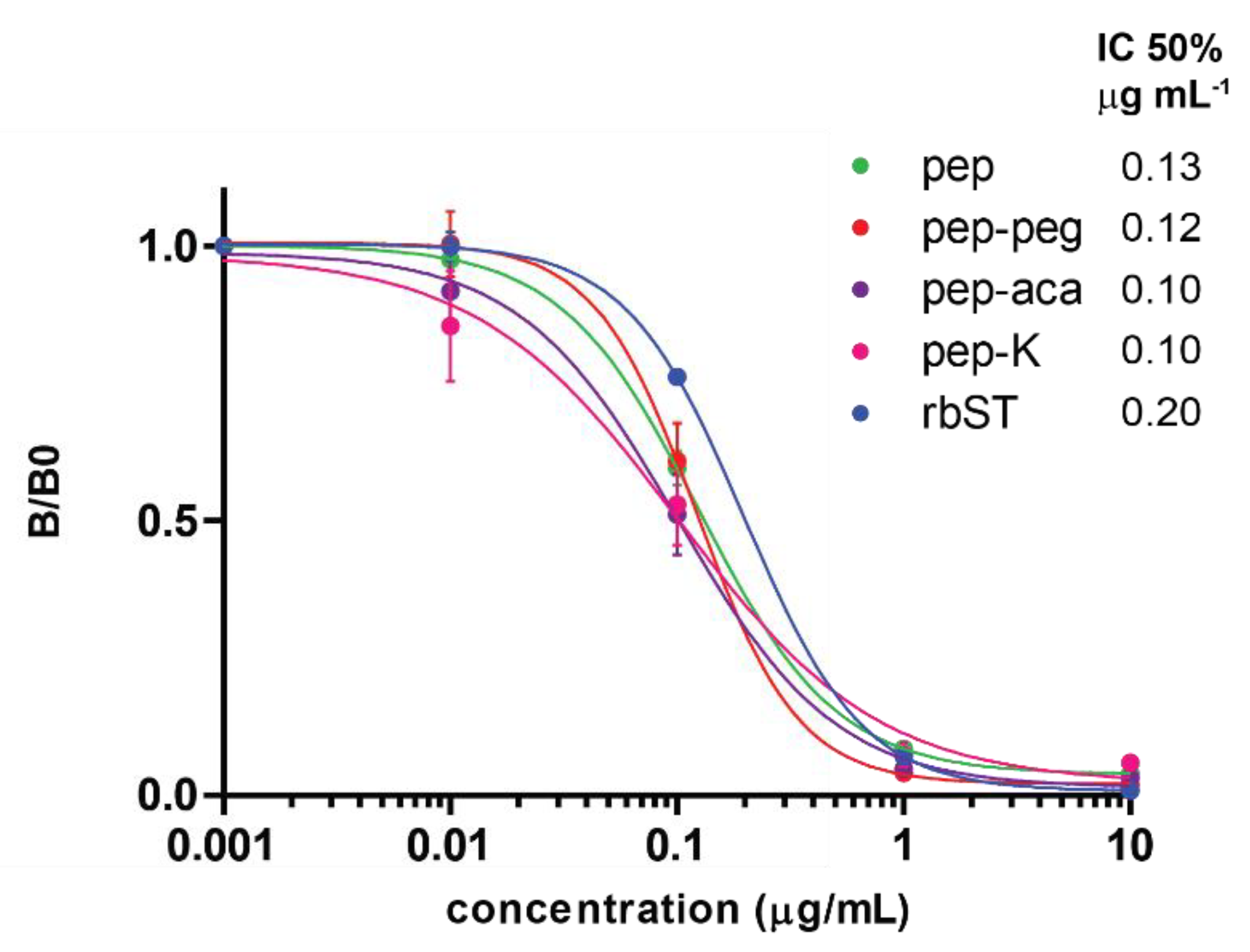
 ), porcine somatotropin (pST,
), porcine somatotropin (pST,  ), equine somatotropin (eST,
), equine somatotropin (eST,  ) and human somatotropin (hST,
) and human somatotropin (hST,  ) (n = 2) in PBST/BSA solution for microspheres coupled with pep (B).
) (n = 2) in PBST/BSA solution for microspheres coupled with pep (B).
 ), porcine somatotropin (pST,
), porcine somatotropin (pST,  ), equine somatotropin (eST,
), equine somatotropin (eST,  ) and human somatotropin (hST,
) and human somatotropin (hST,  ) (n = 2) in PBST/BSA solution for microspheres coupled with pep (B).
) (n = 2) in PBST/BSA solution for microspheres coupled with pep (B).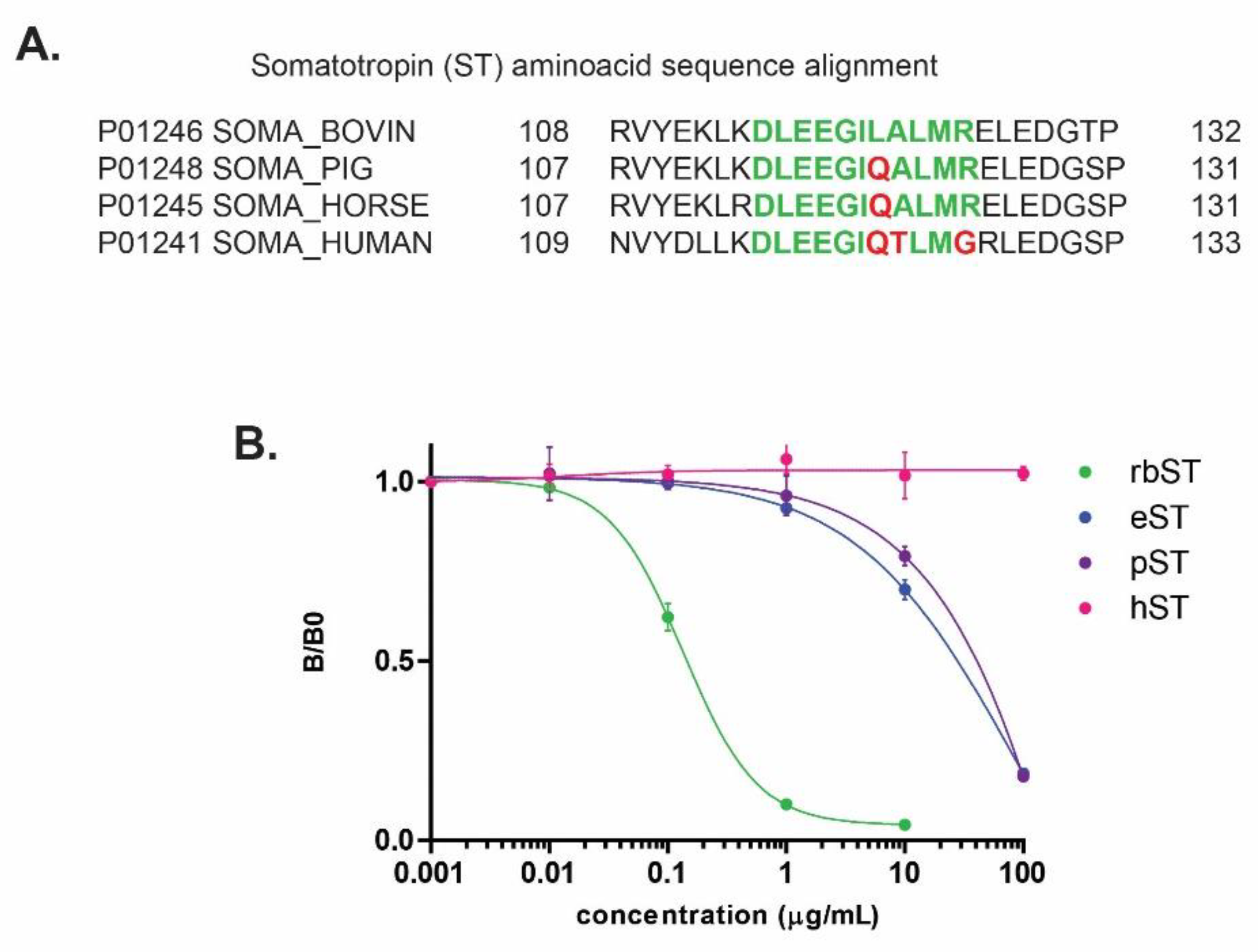
Publisher’s Note: MDPI stays neutral with regard to jurisdictional claims in published maps and institutional affiliations. |
© 2022 by the authors. Licensee MDPI, Basel, Switzerland. This article is an open access article distributed under the terms and conditions of the Creative Commons Attribution (CC BY) license (https://creativecommons.org/licenses/by/4.0/).
Share and Cite
Smits, N.G.E.; Bovee, T.F.H.; Pujari, S.P.; van Ginkel, L.A.; Nielen, M.W.F.; Albada, B. Microsphere Peptide-Based Immunoassay for the Detection of Recombinant Bovine Somatotropin in Injection Preparations. Biosensors 2022, 12, 138. https://doi.org/10.3390/bios12030138
Smits NGE, Bovee TFH, Pujari SP, van Ginkel LA, Nielen MWF, Albada B. Microsphere Peptide-Based Immunoassay for the Detection of Recombinant Bovine Somatotropin in Injection Preparations. Biosensors. 2022; 12(3):138. https://doi.org/10.3390/bios12030138
Chicago/Turabian StyleSmits, Nathalie G. E., Toine F. H. Bovee, Sidharam P. Pujari, Leendert A. van Ginkel, Michel W. F. Nielen, and Bauke Albada. 2022. "Microsphere Peptide-Based Immunoassay for the Detection of Recombinant Bovine Somatotropin in Injection Preparations" Biosensors 12, no. 3: 138. https://doi.org/10.3390/bios12030138
APA StyleSmits, N. G. E., Bovee, T. F. H., Pujari, S. P., van Ginkel, L. A., Nielen, M. W. F., & Albada, B. (2022). Microsphere Peptide-Based Immunoassay for the Detection of Recombinant Bovine Somatotropin in Injection Preparations. Biosensors, 12(3), 138. https://doi.org/10.3390/bios12030138





